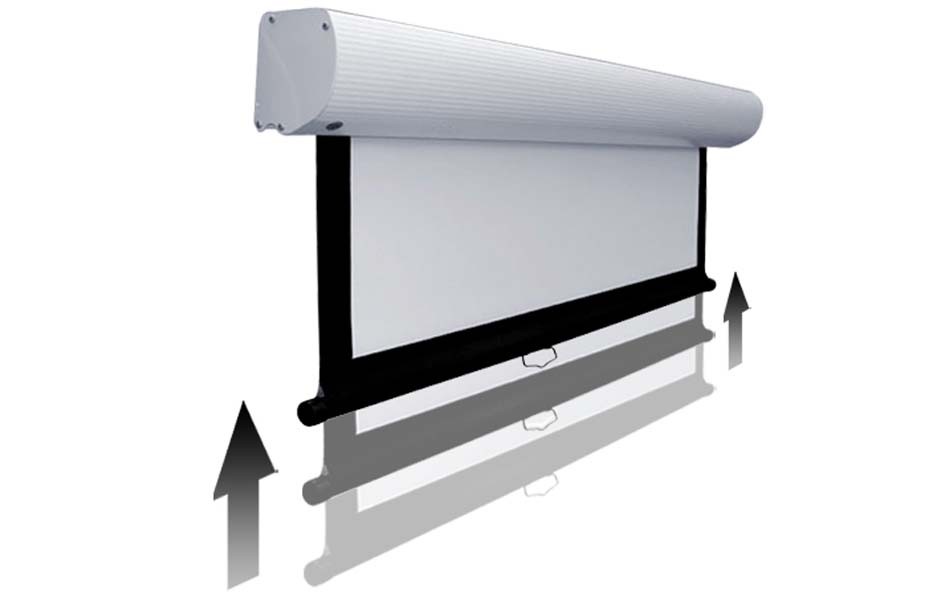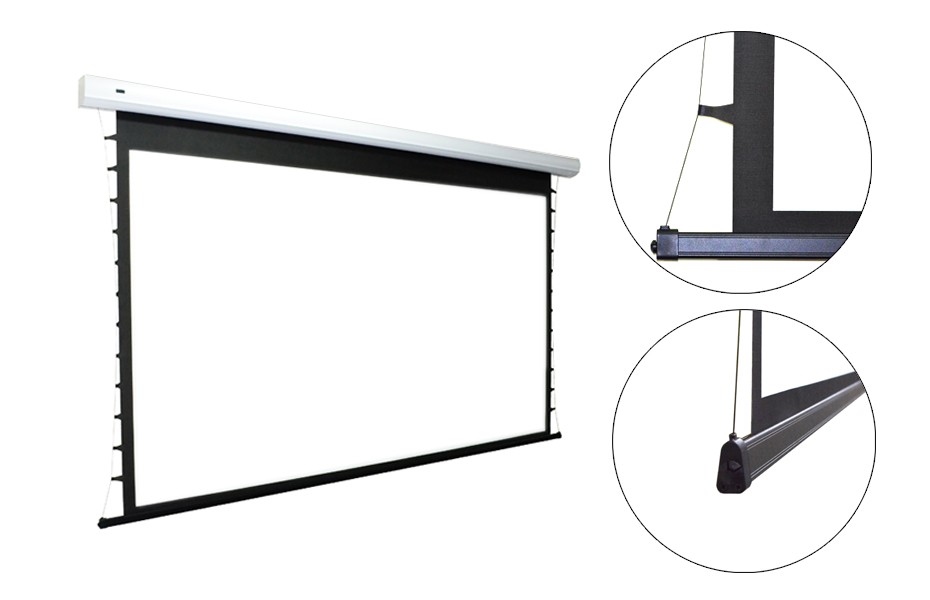
Projector Screens: An Overview

In a home theatre nothing beats a big screen. Most of the time a screen and projector offers better “real estate” in relation to cost than a flat screen LED TV. Meaning you can get much bigger screen sizes (we are talking over 100″) for a fraction of the price of an 80″ flat screen TV.
Here at Rapallo, we manufacture a whole lot of screens. We have the ability to manufacture almost any size, material type and application you can imagine. We understand there is quite a lot of lingo about the type of screens you can get. Tab-tension, acoustic transparent, fixed frame, or gain. We will go over the different definitions of the screen applications, and fabrics available to help you find the right solution for your situation. We will also go over some considerations you need to be aware of for the different types of screens.
Screen applications
Motorised Screen
This screen has a motor inside which electronically drops the screen from the case. They usually come with an Infrared or Radio Frequency remote. A good screen should have a preset memory so when dropping down it will be in the same location. You need to consider where you have access to power. If you are installing a screen yourself you may want to get an electrician to install a power point in or close to the ceiling. These screens are contained in a metal casing that you can choose to mount on a wall or ceiling. Motorised screens tend to be larger than the manual screens. They can be placed higher up on the ceiling, great for home theaters, board rooms, and classrooms to keep a modern, minimalistic look.

In-ceiling Screen
The in-ceiling screen is a recessed clean solution. All of our in-ceiling screen are motorised. This option puts the screen casing into the ceiling, which means a slightly longer installation process. When installing an in-ceiling screen you need to consider the direction of the trusses in the roof. It is easier if the screen is in parallel with the trusses, so there are more possible spaces to install the screen. This screen is the higher end version of the motorised and can be totally hidden in a multi-purpose living space. Imagine being able to recess your screen and our projector into the ceiling (using a projector lift) and instantly turning a living space into a cinema with the touch of a button.

Manual Screen
This is the most affordable screen. It has no bells and whistle, just a handle to pull the screen up and down. It has the ability to hook to a ceiling or wall with the convenient hook-holes or hanging clips. If the screen is too high to reach you may need to think about using a lanyard attach to the handle.

Floor-up Screen (Portable)
This is version of the manual screen, in a portable package. This screen is great for travelling presentations paired up with a bright portable projector. The screen comes with its very own integrated aluminum carry case and handle. Setup is simple and fast, when the screen is required simply fold out the legs and pull the screen from its casing. Hydraulic lift scissor mechanism adjusts the height of the screen instantly with the touch of a finger. It is lightweight and easy to carry and sets up on floor or table. They include enough black ”rise” to clear a tabletop.

Fixed Frame Screen
This screen is basically a big white picture frame. It is particularly popular in dedicated home theatre rooms. This screen sits on brackets on the wall and doesn’t move once installed. They are all tab tensioned with springs hidden in the frame (definition below). Since this screen is tab tensioned and is not constantly being rolled back into a case, it has the greatest longevity over the other screens. If you have a dedicated theatre room, and don’t mind having the screen fixed on the wall, this is your best option. Our regular fixed frame screens come with a thick velvet material edge. This helps soak up any “black-light” that can pour off the edges from the projector.

Tab-tensioned
This is a system applied some of the screens mentioned above (ie: Motorized, In-ceiling, Fixed Frame). A Tab-tensioned screen means the surface is constantly stretched using a spring or cable system on the outer edges of the screen. This results in a flatter surface and keeps the screen crease-free over a longer period of time. A Non-tensioned screen simply allows the screen to hang from the support structure of the screen. Due to the stretched nature of the tab-tensioned screens they maximise light reflectivity and life-span. These screens are preferred for professional and dedicated home cinema use. If a screen is going to be motorised in and out of its case on a daily basis, it is recommended to go for a tab-tensioned option.

Screen Materials
Gain
Gain is the measure of light reflectivity of the screen’s fabric. All of Rapallo’s screen come standard with a screen gain of 1.0. This means that any light that is directed the at screen will reflect back at the same brightness level. If the gain is greater than 1.0 the projector screen fabric reflects a brighter light output, and if it is lower than 1.0 the image will be not as bright. Rapallo are able to change the screen gain for our customers at their request. A case where a higher screen gain is required is in environment such as offices, classrooms, and auditoriums with some ambient light. A higher gain can bring greater brightness and clarity to such environments.
Fabric Colour and Tone
The colour of the screen changes the contrast of the image (in a big way). Our standard screens are white, however we have manufactured grey and tested black screen material before. White material is the most popular due to being able to reproduce brighter images and provide more clarity in the high tones. Whereas grey and black material reproduce deeper blacks and more clarity in darker images. Also grey screens are slightly better for rooms with ambient light providing greater contrast. But users must consider what projector that are using with a grey screen. As the projector needs to have high brightness in order to reproduce the white and lighter colours on such a screen.

Acoustic Transparent
Acoustic transparent screens allow sound waves to travel through the screen. The material is perforated with minute holes. We can’t stress this enough, it doesn’t effect the image whatsoever. We currently have 3 ELAC Muro on-wall speakers behind our screen in the demo room, the image is never hindered because of an acoustic transparent screen (we encourage you to come see for yourself). This type of screen material allows users to place the speakers behind the screen, making for an immersive movie experience. Since almost all dialogue from a movie is directed through the centre channel. Having the sound come directly from the center of the screen, literally feels like the dialogue is coming from the character’s mouth. If you are a perfectionist, the tweeters of the front 3 speakers should be at the same height. This allows for the best blending between the channels. Some of our customers have built a false wall to house the screen and have full sized front speakers behind their screen!


Need Help?
We are more than happy to manufacture a particular type of screen for your needs, with different screen tone or gain. If you can think of it, we can probably make it. Visit our projector screen section on our website where you can easily navigate your way through all our screen categories. CLICK HERE
Come visit our showroom, where there are a few screens types and materials you can see.
If you have any questions about screens you can always call the Rapallo team on (09) 274-4515.
Sources: projectorscreenstore, Rapallo ltd.